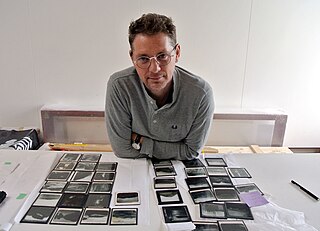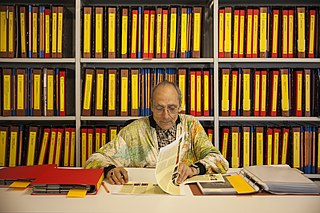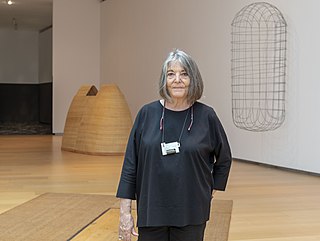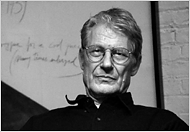Career
The media in which Dujourie works include clay, collage paper, iron, lead, marble, photo, plaster, velvet and video. [2] She personifies the sexuality within her materials, displaying the performative dimension of the artwork. She focuses on what her work is doing externally, rather than simplifying it, giving the ornamental elements of her work a central role. Her subjects center around time, the change between the figurative and the abstract, the sensation of gloominess and searching for an emotional aspect of space. [1]

Wolf Vostell was a German painter and sculptor, considered one of the early adopters of video art and installation art and pioneer of Happenings and Fluxus. Techniques such as blurring and Dé-coll/age are characteristic of his work, as is embedding objects in concrete and the use of television sets in his works. Wolf Vostell was married to the Spanish writer Mercedes Vostell and has two sons, David Vostell and Rafael Vostell.

Jannis Kounellis was a Greek Italian artist based in Rome. A key figure associated with Arte Povera, he studied at the Accademia di Belle Arti in Rome.
Rosemarie Trockel is a German conceptual artist. She has made drawings, paintings, sculptures, videos and installations, and has worked in mixed media. From 1985, she made pictures using knitting-machines. She is a professor at the Kunstakademie Düsseldorf, in Düsseldorf in Nordrhein-Westfalen.

Augusto de Campos is a Brazilian writer who was a founder of the Concrete poetry movement in Brazil. He is also a translator, music critic and visual artist.
Manolo Millares was a Spanish painter.

Brook Andrew is an Australian contemporary artist.
Tim White-Sobieski is a video and installation artist based in New York and Berlin. He was educated as an architect and dedicated himself to visual art and filmmaking, exploring the fields of painting, sculpture, photography, video, video installations and light installations throughout his career. He began showing in New York in the early 1990s with his "Blue Paintings." Emphasis on the role of the subconscious in his paintings had affinities with visual abstractionism and literary existentialism.

Daniel García Andújar is a visual media artist, activist and art theorist from Spain. He lives and works in Barcelona. His work has been exhibited widely, including Manifesta 4, the Venice Biennale and documenta 14 Athens, Kassel. He has directed numerous workshops for artists and social collectives worldwide.
Laureana Toledo is a Mexican conceptual artist.

Antoni Miralda is a Spanish multidisciplinary artist.

Ree Morton was an American visual artist who was closely associated with the postminimalist and feminist art movements of the 1970s.
Ulises Carrión, considered as "perhaps Mexico’s most important conceptual artist", is widely known for his decisive role in defining and conceptualising the artistic genre artists' book through his manifesto The New Art of Making Books (1975). But his alertness and interest in new forms of art and innovative operations implicated that he was active in most of the artistic fields of his time. The activities cover artworks, theory and independent initiatives. This includes not only a great number of bookworks - as he named artists' books - and unique artworks, but also performances, alongside film, video, and sound works, as well as several edition, publishing, and curating projects, a couple of considerable public projects, and various significant works and initiatives within the international community of mail artists during its most creative period. Equally essential for his artistic career is his engagement in several artists' run spaces. All his artistic activities were reflected by him in highly elaborated theories.

Marisa González is a Spanish multimedia artist. She is considered a pioneer in Spain for the use of the new technologies in contemporary art. She works in distinct disciplines like photography, installations, video-art or net-art. She has been Vice President of the association Mujeres en las Artes Visuales MAV, from 2010 until 2016.

Susana Solano is a Spanish sculptor Solano is known for her large-scale sculpture, often made of sheet metal and wire mesh. She lives and works in Barcelona.
María Freire was a Uruguayan painter, sculptor, and art critic. She was one of the leading figures in the development of concrete art and non-figurative art in Uruguay. She was a co-founder the Grupo de Arte No Figurativo.
Liliana Maresca was an Argentine artist. Her works cover a variety of styles including sculpture, painting, graphic montages art objects and installations. She was a prominent artist in the period following the dictatorship of the National Reorganization Process. She was a key figure who participated in the artistic scene since the early 80's, starring the enthusiastic young bohemian that detonated Buenos Aires from the early years of democracy rapidly becoming an inflection figure. Her works included objects, installations, performances, interventions in public and semipublic places, and the photographic performances. Maresca died of AIDS in 1994, just a few days after the opening of her retrospective at the Centro Cultural Recoleta in Buenos Aires.

Concha Jerez is a Spanish multidisciplinary artist known as a pioneer in conceptual art. One of the central axes of her work is the critical analysis of the media.

Dieter Froese (1937-2006) was a pioneering video installation artist who also worked in film, sculpture, and photography.
Alberto Corazón Climent was a Spanish multidisciplinary artist who combined graphic design, sculpture, painting, and photography into his works. Some of his works are housed at contemporary museums including Bilbao Fine Arts Museum, Museum of Contemporary Art, Madrid, and Institut Valencià d'Art Modern. He worked as a graphic designer for clients including the organizations National Library of Spain, Autonomous University of Madrid, Anaya, ONCE, Círculo de Bellas Artes, and Renfe Operadora. He was inducted as the member of the Real Academia de Bellas Artes de San Fernando in 2006.

Fernanda Fragateiro is a Portuguese artist and sculptor who mainly collaborates with architects and landscape architects.











